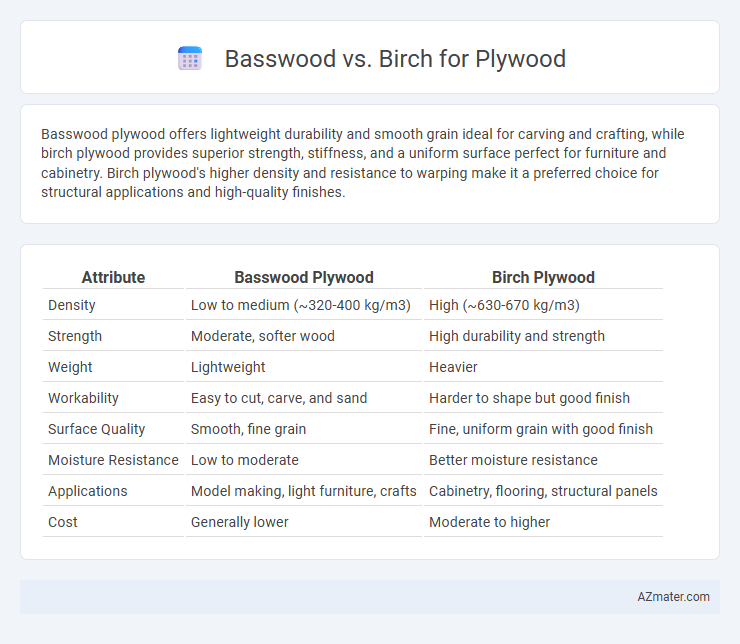Basswood plywood offers lightweight durability and smooth grain ideal for carving and crafting, while birch plywood provides superior strength, stiffness, and a uniform surface perfect for furniture and cabinetry. Birch plywood's higher density and resistance to warping make it a preferred choice for structural applications and high-quality finishes.
Table of Comparison
| Attribute | Basswood Plywood | Birch Plywood |
|---|---|---|
| Density | Low to medium (~320-400 kg/m3) | High (~630-670 kg/m3) |
| Strength | Moderate, softer wood | High durability and strength |
| Weight | Lightweight | Heavier |
| Workability | Easy to cut, carve, and sand | Harder to shape but good finish |
| Surface Quality | Smooth, fine grain | Fine, uniform grain with good finish |
| Moisture Resistance | Low to moderate | Better moisture resistance |
| Applications | Model making, light furniture, crafts | Cabinetry, flooring, structural panels |
| Cost | Generally lower | Moderate to higher |
Introduction to Basswood and Birch Plywood
Basswood plywood is valued for its lightweight, fine grain, and smooth surface, making it ideal for detailed woodworking and crafts that require precision. Birch plywood, known for its strength, durability, and attractive grain patterns, is commonly used in furniture making, cabinetry, and construction projects requiring high load-bearing capacity. Both types offer versatility, with basswood excelling in ease of cutting and finishing, while birch provides superior toughness and resistance to wear.
Botanical Origins and Species Differences
Basswood plywood originates from the Tilia genus, primarily from species like Tilia americana and Tilia cordata, known for their soft, lightweight timber ideal for carving and lightweight construction. Birch plywood comes from Betula species, such as Betula pendula and Betula papyrifera, valued for their hardness, strength, and fine grain, making them suitable for durable furniture and cabinetry. The botanical differences between Basswood and Birch influence their density, workability, and typical applications in plywood manufacturing.
Grain Pattern and Visual Appeal
Basswood plywood features a fine, even grain pattern with a pale, creamy color that provides a smooth surface ideal for painting and staining, making it popular for intricate woodworking and crafts. Birch plywood exhibits a more pronounced, tight grain with a warm, golden hue that enhances natural wood aesthetics, favored for furniture and cabinetry where visual appeal is key. The contrasting grain visibility and color tones between basswood and birch directly influence project outcomes, with basswood offering subtlety and uniformity and birch showcasing rich texture and warmth.
Workability and Machinability
Basswood plywood offers superior workability due to its soft texture, making it ideal for intricate cutting and shaping tasks with minimal blade wear. Birch plywood features higher density and hardness, providing better machinability for load-bearing applications but requiring sharper tools and more careful handling to prevent splintering. Choosing between basswood and birch plywood depends on the precision and durability demands of the woodworking project.
Strength and Durability Comparison
Basswood plywood offers moderate strength and is lightweight, making it suitable for applications requiring minimal load-bearing capacity. Birch plywood provides superior strength and durability, featuring a dense, hard grain that resists impact and wear, ideal for heavy-duty construction and furniture. The higher density and hardness of birch plywood contribute to its enhanced structural stability and longevity compared to basswood.
Weight and Density Considerations
Basswood plywood typically has a lower density around 320-400 kg/m3, resulting in a lighter final product ideal for applications where weight reduction is crucial, such as in model making or lightweight furniture. Birch plywood, with a density ranging from 600 to 700 kg/m3, offers a denser and heavier board that provides superior strength and durability but adds significant weight. Understanding the balance between basswood's lightweight nature and birch's robust density is essential for selecting plywood tailored to structural needs and weight constraints.
Cost and Availability
Basswood plywood generally offers a more affordable option due to its widespread availability in North America, making it cost-effective for large-scale projects. Birch plywood, while slightly more expensive, provides superior strength and a smooth finish, though its availability can be limited depending on the region, potentially increasing costs through specialized sourcing. Choosing between basswood and birch plywood depends on balancing budget constraints with the desired durability and aesthetic quality in woodworking applications.
Environmental Impact and Sustainability
Basswood plywood generally exhibits a lower environmental impact due to its faster growth rate and higher renewability compared to birch, which requires longer maturation periods, thereby increasing resource consumption. Birch plywood, while more durable and dense, often involves more intensive harvesting practices that can contribute to deforestation and habitat disruption if not sourced responsibly. Sustainable sourcing certifications like FSC or PEFC are critical for both woods to ensure eco-friendly harvesting, with basswood offering a more favorable sustainability profile in terms of carbon sequestration and regeneration speed.
Typical Uses in Woodworking and Construction
Basswood plywood is preferred for detailed woodworking projects due to its fine grain, smooth surface, and ease of carving, making it ideal for cabinetry, musical instruments, and model building. Birch plywood offers higher strength and durability with a harder surface, commonly used in furniture making, flooring, and construction where structural stability and wear resistance are essential. Both woods serve distinct purposes: basswood excels in precision crafts, while birch is favored for robust applications requiring long-term performance.
Final Verdict: Choosing the Right Plywood for Your Project
Basswood plywood offers a lightweight, smooth surface ideal for detailed carving and painting, making it perfect for artistic and decorative projects. Birch plywood stands out for its superior strength, durability, and resistance to warping, suitable for structural applications and furniture that requires solid support. Selecting the right plywood depends on balancing the need for fine finish and ease of use (Basswood) versus robustness and longevity (Birch) to best match the demands of your specific project.

Infographic: Basswood vs Birch for Plywood
 azmater.com
azmater.com